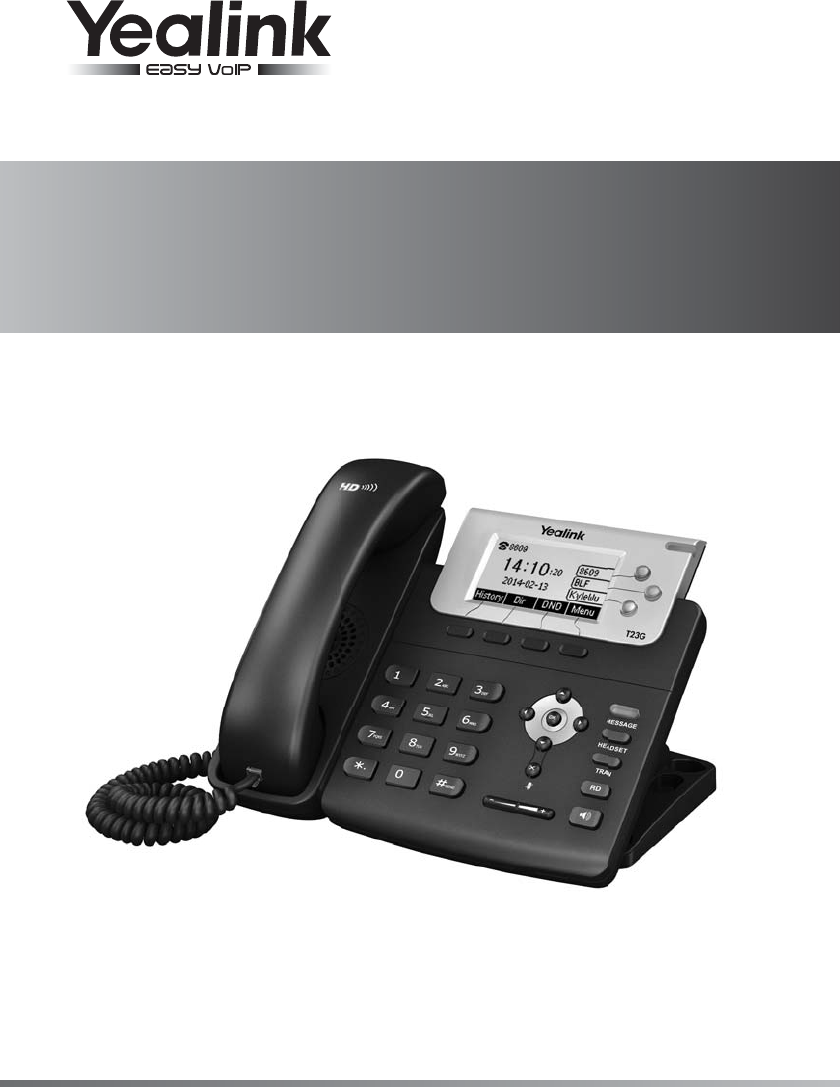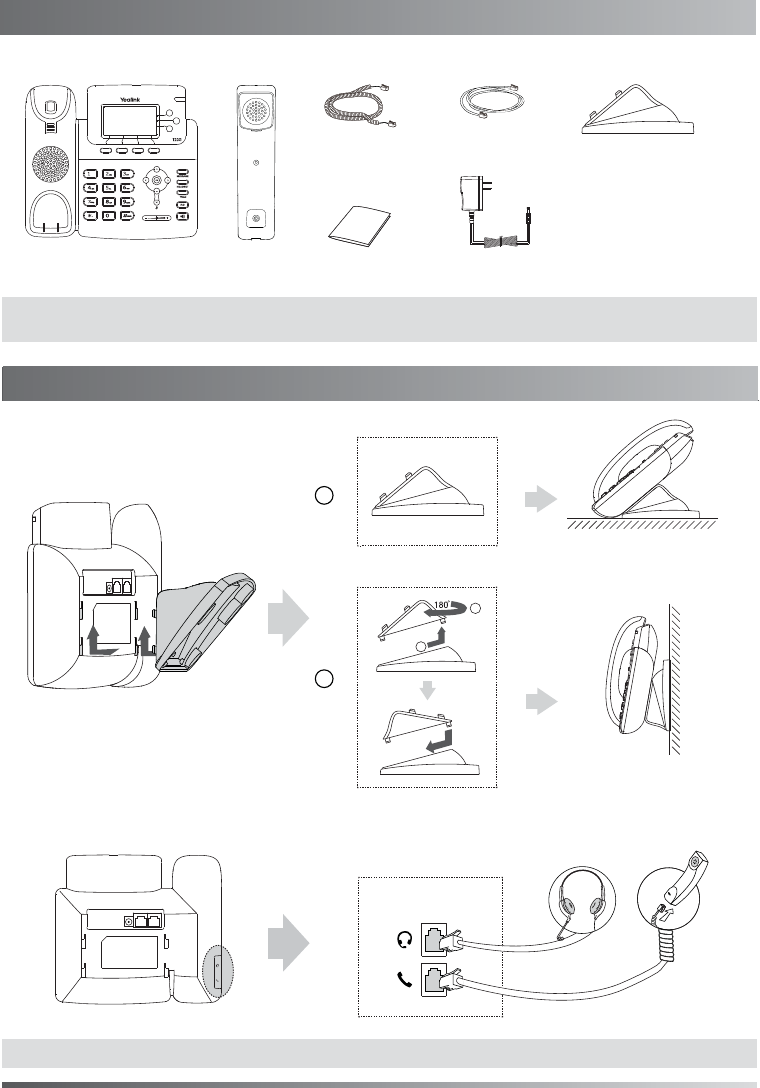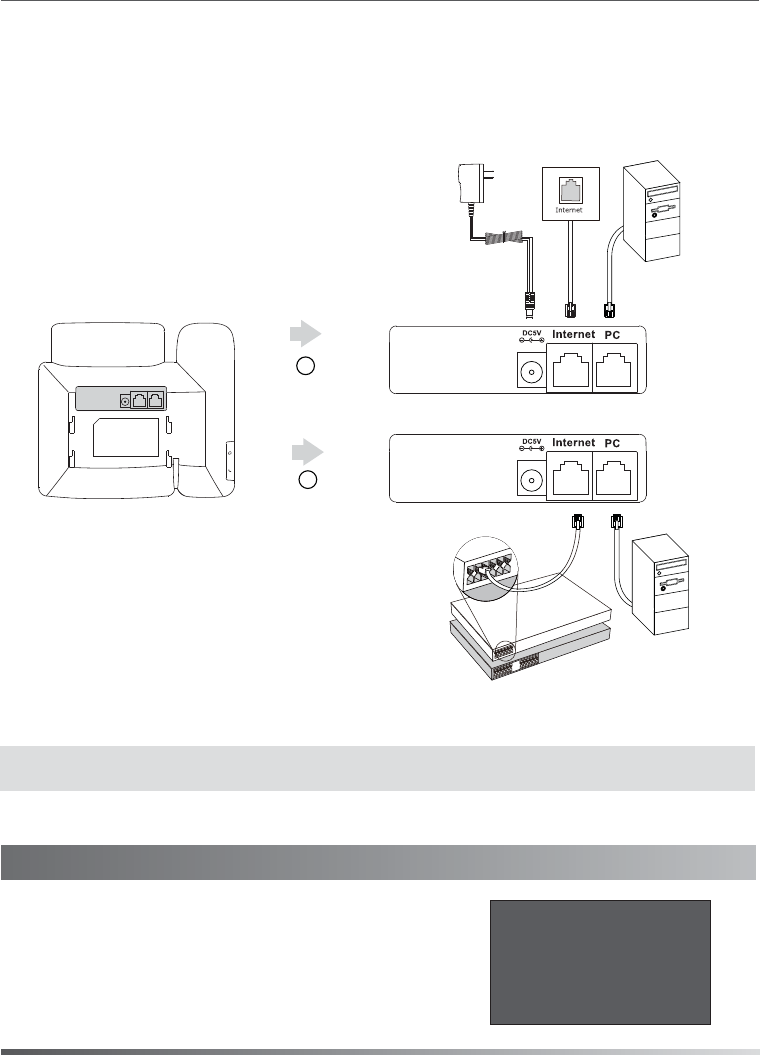YEALINK T23G IP Phone User Manual Part One
YEALINK (XIAMEN ) NETWORK TECHNOLOGY CO., LTD. IP Phone Users Manual Part One
YEALINK >
Contents
- 1. Users Manual Part One
- 2. Users Manual Part Two
Users Manual Part One

Quick Start Guide (V80.1)
www.yealink.com Applies to firmware version 44.80.0.1 or later.
SIP-T23 & T23P & T23G
Enterprise IP Phone

Assembling the Phone
Handset Cord
Handset
IP Phone
Ethernet Cable
Power Adapter
(Optional)
2
Quick Start Guide
Packaging Contents
The following items are included in your package. If you find anying missing, contact your system administrator.
Packaging Contents
Assembling the Phone
Note: The headset should be purchased separately.
2.Connect the handset and optional headset, as shown below:
1.Attach the stand,as shown below:
A
B
Desk Mount Method
Wall Mount Method
Stand
Note: The models displayed on the phone differ from each other. The packaging content "IP Phone" listed above takes
a SIP-T23G IP phone as an example.
1
2

3
Startup
3.Connect the network and power, as shown below :
You have two option for network and power connections. Your system administrator will advise you on which one to use.
Note: PoE is applicable to the SIP-T23P & T23G IP phones. If inline power (PoE) is provided, you do not need to
connect the power adapter. Make sure the hub/switch is PoE-compliant.
After the IP phone is connected to the network and
supplied with power, it automatically begins the
initialization process. After startup, the phone is ready
for use. You can configure the phone via phone user
interface or web user interfafce.
AC Power Option
A
B
PoE ( Power over
Ethernet ) Option
PC Connection
(Optional)
Power Adapter
(DC 5V)
PC Connection
(Optional)
IEEE 802.3af compliant
PoE Hub/Switch
Welcome
Initializing... please wait

Registering
Configuring Your Phone
Register status icons on the LCD screen:
Registered Register Failed
4
Configuring Your Phone
Configuring via web user interface
Accessing the web user interface:
1. Press the OK key when the phone is idle to obtain the IP address of the phone.
2. Open the web browser of your computer, enter the IP address into the address bar (e.g., "http://192.168.0.10" or
"192.168.0.10"), and then press the Enter key.
3. Enter the user name (default: admin) and password (default: admin) in the login page and click Confirm.
Note: Check with your system administrator if any error appears during the registration process or if a specific
configuration is required for your registration.
Note: The wrong network settings may result in inaccessibility of your phone and may have an impact on the network
performance. Contact your system administrator for more information.
Account Settings: Click on Account->Register->Account X (X=1,2,3)
Parameters of the account:
Register Status:
Line Active:
Label:
Display Name:
Register Name:
User Name:
Password:
Server Host:
It is provided by ITSP for registration (required).
It is provided by ITSP for registration (required).
It is authenticated ID for authentication provided by ITSP (required).
It is shown as Caller ID when placing a call.
It is shown on the LCD screen to identify the account.
You can select Enabled/Disabled to enable/disable the account.
It shows the register status of the current account.
Note: For more information on account parameters, refer to Configuring via web user interface.
Network Settings: Click on Network->Basic->IPv4 Config
You can configure the network settings in the following ways:
DHCP: By default, the phone attempts to contact a DHCP server in your network to obtain its valid network settings,
e.g., IP address, subnet mask, gateway address and DNS address.
Static IP Address: If your phone can not contact a DHCP server for any reason, you need to configure the IP address
subnet mask, gateway address, primary DNS address and secondary DNS address for the phone
manually.
PPPoE: If you are using an xDSL modem, you can connect your phone to the Internet via PPPoE mode. Contact the
ITSP for the PPPoE user name and password.
It is provided by ITSP for registration (required).
Configuring via phone user interface
Network Settings:
Press the Menu soft key when the phone is idle, select Settings->Advanced Settings (default password:admin)->Network
->Dns Server/WAN Port/VLAN/Webserver Type/802.1x Settings/VPN/SIP Setting to configure the network.
Account Settings:
Press the Menu soft key when the phone is idle, select Settings->Advanced Settings (default password:admin)->Accounts to
configure the account.

Placing a Call
Answering a Call
Ending a Call
Using the handset:
Using the speakerphone:
Using the headset:
Using the handset:
Using the speakerphone:
Using the headset:
Using the handset:
1. With the handset on-hook, press .
1. Pick up the handset.
2. Enter the number, and then press the Send soft key.
1. With the headset connected, press to activate the headset mode.
2. Enter the number, and then press the Send soft key.
2. Enter the number, and then press the Send soft key.
Pick up the handset.
Press .
Hang up the handset or press the End Call soft key.
Press .
5
Basic Call Features
Note: During a call, you can alternate between the headset, hands-free speakerphone and handset modes by pressing
the HEADSET key, the Speakerphone key or by picking up the handset. Headset mode requires a headset
connected.
Note: You can ignore an incoming call by pressing the Reject soft key.
Call Mute and Un-mute
Call Hold and Resume
To place a call on hold:
To resume the call, do one of the following:
Press to mute the microphone during a call.
Press again to un-mute the call.
If there is only one call on hold, press the Resume soft key.
Press the Hold soft key during an active call.
Press twice when the phone is idle to dial out the last dialed number.
Using the speakerphone:
Using the headset:
Press or press the End Call soft key.
Press the End Call soft key.
Redial
Press to enter the Placed calls list, press or to select the desired entry, and then press
or the Send soft key.
If there is more than one call on hold, press or to select the desired call, and then press the Resume
soft key.

6
Call Conference
1. Press the Conf soft key during an active call. The call is placed on hold.
Blind Transfer
Call Transfer
You can transfer a call in the following ways:
1. Press or the Tran soft key during a call. The call is placed on hold.
3. Press or the Tran soft key.
2. Enter the number you want to transfer to.
Call Forward
To enable call forward:
Always Forward----Incoming calls are forwarded unconditionally.
Busy Forward----Incoming calls are forwarded when the phone is busy.
No Answer Forward----Incoming calls are forwarded if not answered after a period of time.
2. Select the desired forward type:
4. Press the Save soft key to accept the change.
Semi-Attended Transfer
Attended Transfer
1. Press or the Tran soft key during a call. The call is placed on hold.
1. Press or the Tran soft key during a call. The call is placed on hold.
2. Enter the number you want to transfer to, and then press .
3. Press or the Tran soft key when the second party answers.
2. Enter the number you want to transfer to, and then press .
3. Press or the Tran soft key when you hear the ring-back tone.
3. Enter the number you want to forward to. For No Answer Forward, press or to select the ring time to wait
before forwarding.
4. Press the End Call soft key to disconnect all parties.
2. Enter the number of the second party, and then press the Send soft key.
3. Press the Conf soft key again when the second party answers. All parties are now joined in the conference.
Note: You can split the conference call into two individual calls by pressing the Split soft key.
1. Press the Menu soft key when the phone is idle, and then select Features->Call Forward.
Speed Dial
To configure a speed dial key:
To use the speed dial key:
1. Press the Menu soft key when the phone is idle, and then select Features->DSS Keys.
2. Select the desired line key, and then press the Enter soft key.
4. Press the Save soft key to accept the change.
Press the speed dial key to dial out the preset number.
3. Select Speed Dial from the Type field, select the desired line from the Account ID field, and enter the nubmer in the
Value field.